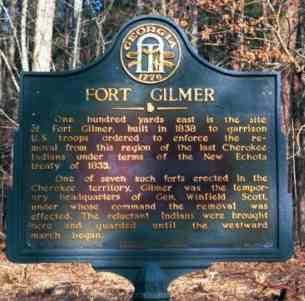Reclaiming Displaced Heritages:
an overview of the Georgia Team's approach
by Leslie WalkerReclaiming Displaced Heritages
Based on a philosophy of "who we are today and who we are tomorrow depends on our legacy from the past," we took the national theme of Reclaiming Displaced Heritages and focused locally on re-examining the Cherokee Removal - a historical moment in time in our community in Northwest Georgia. Although team members came from diverse school settings (ranging from inner city to Atlanta to rural towns and from a wide span of grade levels and subjects, (elementary to high school), we became a collaborative research team working to create resources for educators interested in teaching about a displaced heritage in our community. And because this theme is universal, these strategies can be adapted to any research community.
We started with zero information, only the texts we had read for the institute, Pushing the Bear and Mountain Windsong.We brainstormed places to go to find resources: State archives, web sites, the library and the city's History Center. We made a list of sites to visit in the Northwest Georgia area: Etowah Indian Mounds, New Echota, and the Chief Vann House in Chatsworth, the Funk Heritage Museum at Rinehart College. And we made the discovery that a history professor on campus was not only part Cherokee, but also a contributor to the design of the New Echota site. This professor met with us and graciously shared his collection of Cherokee artifacts: copies of documents from the Removal with lists of names, properties and possessions, maps of stockade markers where the Cherokee were held before the removal, and names of publications produced by the Cherokee today. Another connection through the college lead us to a graduate writing student who wanted to write a play about the removal.
We started collecting articles from the local newspaper whenever the Cherokee where mentioned. These articles lead us to sources we had not considered before: an archivist at a local private school, a Presbyterian Church near the Chattahoochee River that owned a collection of Cherokee artifacts, sites on the Chattahoochee where the Cherokee used to fish.
Along the way, we confronted multiple issues related to the recovery and study of diverse cultures. Questions we needed to address included: Who has the right to tell a people's story? How can stories from "other's" pasts best be recovered, safeguarded, and disseminated? How do we maintain the momentum of our research, while maintaining our own classrooms?
By the end of the year, after starting with zero, the products of our research included an annotated bibliography, a timeline of the Removal, a play, an introduction to the play appropriate for middle schoolers, and a consciousness of our community's legacy from the past.
Where the Deer Ran: an Original Historical Drama a pdf document (Acrobat Reader needed for viewing)
by Adam Russell
Historical Background for Where the Deer Ran: Events Leading to the Cherokee Removal
by Patsy Hamby
New Echota Historic Site Virtual Toura PowerPoint presentation (PowerPoint viewer required for viewing)
by Stacie Janecki (KSU Honors Student)
Reclaiming Displaced Heritages: An Annotated Bibliography
by Leslie Walker and Rozlyn Truss
Content Design/Management: Traci Blanchard,Stacie Janecki and Marty Lamers
Home | Curricular
Program | Thematic Content
Classroom Resources
| Community Projects |
Who We Are
© 2000-2001KCAC
No materials on this website should be copied or distributed
(except for classroom use) without written permissions from KCAC.
Questions? Comments? Contact KSU webmaster
Jim Cope.

